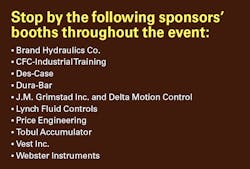The Fluid Power Conference & Expo returns to Milwaukee, with the Milwaukee School of Engineering (MSOE) hosting the event Tuesday and Wednesday, June 11-12. Milwaukee also is home to the Fluid Power Institute and the National Fluid Power Association, so many consider it the geographic center of North America’s fluid power industry.
The Conference & Expo gives OEMs, users, and distributors the ability to learn more about technologies, components, and services they can incorporate into their designs. Numerous technical sessions are scheduled on basics and troubleshooting, while others are presented by manufacturers to offer more details on specific technologies and components.
In addition to the conference and an opportunity to visit manufacturers' booths, attendees can network with them during a special cocktail reception on Tuesday evening, courtesy of Brand Hydraulics Co.
Finally, on Wednesday morning, attendees can join a breakfast tour of the Grohmann Museum at MSOE, which is home to an art collection dedicated to the evolution of human work. A tour of the MSOE fluid power lab will also be offered.
Keynote address: The Future of the Fluid Power Industry
The opening keynote address will discuss how an integrated supply chain, new fluid power technologies, and a more-educated workforce will advance the effectiveness of fluid power technology.
Presented by Eric Lanke, National Fluid Power Association
Hydraulic System Troubleshooting Part 1
This session introduces a systematic approach to troubleshooting, which identifies malfunctions and finds their most likely causes instead of using ineffective trial-and-error component replacement techniques. Attendees will also learn the differences between electrical problems and fluid power problems and how to tell them apart.
Presented by Thomas Wanke, CFPE, Fluid Power Institute at the Milwaukee School of Engineering
Sponsored by Webster Instruments
Mobile and Industrial Electrohydraulic Systems
This course will cover the principles and components utilized in current design mobile and industrial proportional and servo systems. Participants will be exposed to concepts, valves, feedback devices and controllers that are utilized in a variety of applications. Open- and closed-loop techniques will be discussed in detail. Proportional sectional directional control valves with IEC 61131 compliant mobile controllers will be detailed in comparison to precision industrial closed-loop systems.
Presented by Jon Rhodes, CFC Industrial Training
Introduction to Hydraulics 1
This session provides a basics for a comprehensive understanding of hydraulic and pneumatic (fluid power) systems. It compares fluid power to other forms of power transmission and discusses the advantages and disadvantage of each. It also explains the basic parameters (pressure, flow, geometry, force, torque, efficiency, etc.) and calculations for working with fluid power components and systems. Attendees will then learn of the basic components that make up a fluid power system, the standard graphic symbols of each, and how to create a basic circuits.
Presented by Tim Kerrigan, Fluid Power Institute at the Milwaukee School of Engineering
Avoiding Pitfalls of Design Mistakes
This presentation covers design errors that often find their way into fluid power circuit designs, resulting in erratic operation, poor performance or efficiency, or machine malfunctions. The session will examine some of the most common design flaws and how to avoid or correct them. The presentation will cover hydraulics and pneumatics in both stationary and mobile equipment.
Presented by Jon Rhodes, CFC Industrial Training
Hydraulic System Troubleshooting Part 2
This session picks up where part one left off by introducing realistic system malfunctions and having attendees apply troubleshooting techniques they have learned to find the likely sources of the malfunctions. The session also introduces preventive maintenance techniques that can extent help prevent future malfunctions and extend component life.
Presented by Thomas Wanke, CFPE, Fluid Power Institute at the Milwaukee School of Engineering
Sponsored by Webtec-Webster Instruments
Designing More Energy Efficient Systems
This session offers tips on improving energy efficiency in fluid power systems without sacrificing performance. Topics will include pumps and controls, prime movers, valves, line sizing, actuators, and even some little known tricks of the trade. The presentation will cover hydraulics and pneumatics in both stationary and mobile equipment.
Presented by Jon Rhodes, CFC Industrial Training
Sponsored by Brand Hydraulics Co.
Introduction to Hydraulics 2
This session continues a tutorial on fluid power systems by explaining how basic components become building blocks for designing circuits that control direction, force, torque, speed, acceleration, and deceleration. It also covers proportional and discrete control, solenoids, sequential control, and safety.
Presented by Tim Kerrigan, Fluid Power Institute at the Milwaukee School of Engineering
Tips and Tricks for Circuit Design
This presentation explores circuits, sub-circuits, and components to improve fluid power system designs. Attendees will advance their design skills to the next level, resulting in systems with improved functionality, greater reliability, higher efficiency, less leakage, and more compact design. The presentation will cover hydraulics and pneumatics in both stationary and mobile equipment.
Presented by Jon Rhodes, CFC Industrial Training
Closed-Loop Control with Practical Second Order System Consideration
Considerations and techniques for closing the control loop of electrohydraulic systems, including the valve, actuator, sensors and motion controller. Precision positioning and speed control can be seemlessly coupled with accurate pressure/force control to deliver improved product quality while maintaining smoother motion and longer life for machine components in both small and large machine appliances.
Presented by Peter Nachtwey, President, Delta Computer Systems Inc.
Effective Manifold Design; An Innovative Manufacturers' Perspective In the World of Automation
Today’s age of automation allows for compact and efficient manifold system design and manufacturing; reducing weight, hose & fitting requirements, system complexity and overall serviceability, allowing for ease of maintenance in the field, minimizing downtime and disruption in your real-world application. Gain the competitive edge in designing cost effective hydraulic manifold systems. Learn effective manifold design processes from an innovative manufacturer deeply immersed in today’s world of automated production techniques. This presentation will take you through the manifold production process including, manifold design requirements & parameters, programming, complete robotic end to end cell production & flexible manufacturing, paperless final assembly, validation and protective packaging. A good design can save thousands of dollars that will eventually find their way to your bottom line.
Presented by Attilio Treglia, P. E., Lynch Fluid Controls Inc.
On many applications, accumulators can be used to reduce pump and motor sizes which can result in substantial savings on the initial cost of equipment as well as reduced operating costs.
Presented by Jim Tobul, Tobul Accumulator Inc.
Manufacturing Benefits of Ductile Iron Components in High Pressure Systems
Until recently, pressure ratings for ductile iron components were based on book values and theoretical calculations and have been somewhat conservative. This presentation will highlight the manufacturing benefits that can be gained by using continuously cast ductile iron bar stock for ductile iron components. The recent developments being done at Milwaukee School of Engineering determining the pressure ratings for ductile iron will also be presented. Presented by Bob O’Rourke, Dura-Bar
Cyclone Reservoir for Hydraulic Applications – A Technical Overview
At a fraction of the size of traditional reservoirs, the revolutionary Cyclone Reservoir utilizes well known cyclonic technology to rapidly remove free air and gasses from fluid prior to being returned to the pump inlet. Learn about this game-changing technology and how it can remove fluid weight, volume and substantial cost from your platform.
Presented by Terry Glidden and Bob Doll, Price Engineering
Designing Hydraulic Circuits with HyDraw CAD
This session introduces modern techniques for CAD systems to remember data, relationship, and company standards. It demonstrates efficient ways to select components, and generate Automatic Bills of Materials within the AutoCAD environment. ISO standards and symbols will be discussed, and time-saving drafting techniques will be discussed. VEST's HyDraw CAD will be used for demonstration.
Presented by Yudi Raina, VEST Inc.
Methods to Adjust the Characteristic Curves of Electrohydraulic Proportional Valves in Mobile Applications
Because the benefit of electrohydraulics applications in mobile machinery are approved by the market, many proportional pressure reducing valves are often used in pilot stages. Despite of high development effort and optimized production processes, small deviations between the valves (valve-to-valve accuracy) cannot be avoided. For some applications it is necessary to adjust the valve characteristics very accurately. This session shows different examples of valve adjustment with and without the compensation of the hydraulic main stages including new approaches in mechanical and electronic adjusting. The systems are compared with regards to functionality, price, and benefit.
Presented by Mark Jankowski CFPHS, PS, S, Thomas Magnete USA
Fast and Efficient Off-Line Kidney Loop Fluid Conditioning
When working with original equipment manufacturers, hydraulic system designers and plant maintenance engineers, one of the key factors for long system life and low down time is to provide isolated ‘Off Line Kidney Loop Fluid Conditioning & Monitoring.’ Hydraulic system efficiency, eliminating break downs and predictive maintenance are all keys that play a significant role in clients being able to more efficiently manage their hydraulic applications and systems, while maintaining peak power and efficiency of those systems. In the field of fluid contamination, ‘Cool Loop’ off line kidney circuits become a key component in the monitoring of hydraulic circuits where OEM’s/MRO’s are guarding against machine failure without disruption and system spikes, by isolating key system components such as; Filtration and Coolers. Today’s hydraulic system capital expenditures and machine downtime misfortunes are too costly for anyone to miss this seminar.
Presented by: Tim McDonald, Thermal Transfer Products
Visit www.fluidpowerexpo.com/msoe for complete session descriptions, up-to-date conference schedules, and a list of exhibitors. Register now with the discount code PREVIEW to extend the early bird rate of $110 for a full day of sessions and $215 for both days. Lunch and printed course materials for one or both days are included in the registration fee.



